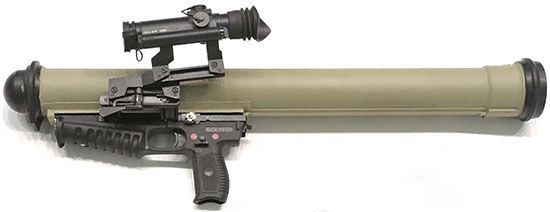4.5x40R SPP-1M underwater 4 barrel pistol
Энциклопедия вооружения
Каталог вооружения
Патрон 4.5×40 R
Патрон 4.5x40R, 1969, Россия

Тактико-технические характеристики патрона 4.5×40 R (СПС)
Калибр, мм – 4,5х40 R (СПС)
Длина патрона, мм – 145
Длина пули, мм – 115
Масса патрона, г – 21
Масса пули, г – 13,2
Средний вес порохового заряда, г – 1,3
Начальная скорость, м/с – 240
Максимальное давление пороховых газов, кг/см2 – 2900
Дульная энергия, дж – 412
Средняя кучность R50 на воздухе на дальности 5 м, см – ≤5,0
В 1969 году для нужд Военно-Морского флота и вооружения боевых пловцов ВМФ СССР в Советском Союзе были начаты работы по созданию подводного огнестрельного оружия. В результате были разработаны два подводных комплекса, пистолетный и автоматный, основанные на активном принципе метания пули.
В состав пистолетного комплекса, разработанного ЦНИИ Точного Машиностроения, вошел 4,5-мм патрон СПС (со стальной пулей) и специальный пистолет подводный СПП-1 (СПП-1М), который был принят на вооружение военно-морских сил СССР в 1970 году.
 СПП-1, СПП-1М (Специальный Пистолет Подводный) – российский (советский) подводный пистолет, стал личным оружием пловца-аквалангиста, предназначенным для поражения подводных целей, как диверсантов, так и морских хищников. Огонь из пистолета ведется одиночными выстрелами. Пистолет несамозарядный, имеет блок из четырех стволов (стволы гладкие, без нарезов), откидывающийся на шарнире вниз для перезаряжания.
СПП-1, СПП-1М (Специальный Пистолет Подводный) – российский (советский) подводный пистолет, стал личным оружием пловца-аквалангиста, предназначенным для поражения подводных целей, как диверсантов, так и морских хищников. Огонь из пистолета ведется одиночными выстрелами. Пистолет несамозарядный, имеет блок из четырех стволов (стволы гладкие, без нарезов), откидывающийся на шарнире вниз для перезаряжания.
 Специальный патроны для этого пистолета объединяются в один блок при помощи плоской стальной обоймы, и извлекаются из стволов или заряжаются в них одновременно.
Специальный патроны для этого пистолета объединяются в один блок при помощи плоской стальной обоймы, и извлекаются из стволов или заряжаются в них одновременно.
Боекомплект пистолета СПП-1 включает 16 патронов 4.5×40 R в 4 обоймах (одна с пистолетом в кобуре, три в герметичных металлических пеналах).
Первый вариант активного патрона разработки Ширяева Д.И. состоял из латунной гильзы с рантом, длинной цельнометаллической пули из нержавеющей стали и заряда пороха марки ВТ. Пуля имела плоскую вершинку и винтовые наклонные нарезы, для придания дополнительной закрутки. Диаметр пули составлял 4,5-мм только в области ведущего пояска, а диаметр тела по всей длине пули составлял 3,95 мм.

Для этого пистолета Матвейкиным и Касьяновым были разработаны варианты пуль, получивших обозначения «турбовинтовая» и «турбопропеллерная», которые отличались повышенной устойчивостью траектории движения под водой.
Поначалу в мелкосерийное производство был запущен патрон с турбовинтовой пулей, имевшей четыре наклонных проточки на вершинке пули. От опытной пули Ширяева, эта пуля отличалась меньшей массой – 13,2 г против 13,5 г, диаметр пули – 4,41 мм против 3,95 мм, пуля была короче на 30 мм, и у неё отсутствовал ведущий поясок. Пуля имела защитное антикоррозийное лаковое покрытие.

Так как обычные пули в воде теряют эффективность уже на самых малых дальностях (менее 1 метра), для подводного пистолета был разработан специальный патрон, отличительной особенностью которого стала иглообразная пуля большого удлинения.
По сути дела, эта стальная пуля массой 13,2 г представляла собой удлиненный стальной стержень длиной 115 мм (соотношение длины к калибру — 25:1). По форме наружного очертания пуля имела удлиненную ведущую часть и оживал, при этом заостренный оживал пули был выполнен на конус. Вершина оживала имела притупленную форму.
Позднее было установлено, что стабилизация пули достигается не за счёт закрутки пули при помощи винтовых насечек, а за счёт эффекта кавитации. Для обеспечения устойчивости кавитационного эффекта была изменена форма кончика пули на усечённый конус.
 Во время стрельбы в воде пуля подобной конструкции при высокой скорости движения стабилизировалась гидродинамически за счет кавитационной полости (каверны), генерируемой небольшой плоской площадкой на переднем заостренном конце пули, которая удерживалась на протяжении всего полета пули.
Во время стрельбы в воде пуля подобной конструкции при высокой скорости движения стабилизировалась гидродинамически за счет кавитационной полости (каверны), генерируемой небольшой плоской площадкой на переднем заостренном конце пули, которая удерживалась на протяжении всего полета пули.
Благодаря этому пуля имела эффективную дальность стрельбы из пистолета СПП-1 (СПП-1М) составляет на глубине 5 метров – до 17 метров, на глубине 20 метров – до 11 метров. На этих дистанциях пуля калибра 4,5 мм обеспечивает поражение живой цели, защищенной маской из оргстекла толщиной до 5 мм и одетой в утепленный поролоновый костюм с дополнительно укрепленными 5-мм пластинами из фибергласса. Форма пули обусловила и то обстоятельство, что стволы перспективного подводного пистолета должны были быть гладкими, без нарезов.
Общая длина 4,5 мм патрона СПС составляла 145 мм, а масса — 21 г. Полет такой удлиненной пули патрона СПС в воздухе никак не стабилизировался, поскольку для пули большого удлинения стабилизация вращением была неэффективна, и она из-за своих формы и габаритов быстро теряла устойчивость. Поэтому стрельба в воздушной среде патронами СПС была возможна только на очень на малой дальности — до 20 м, однако она сохраняет убойное действие и наносит достаточно серьезные ранения. Начальная скорость пули на воздухе составляет 250 м/с, дульная энергия — 412 Дж.
 Латунная гильза патрона СПС (4.5×40 R) — бутылочной формы, фланцевая (с выступающей закраиной) длиной 40 мм, предназначалась для соединения в одно целое всех элементов патрона, а также облегчала заряжание оружия и предохраняла пороховой заряд от влияния внешних условий. Для этого были предприняты специальные меры по герметизации и повышению коррозионной стойкости подводного патрона.
Латунная гильза патрона СПС (4.5×40 R) — бутылочной формы, фланцевая (с выступающей закраиной) длиной 40 мм, предназначалась для соединения в одно целое всех элементов патрона, а также облегчала заряжание оружия и предохраняла пороховой заряд от влияния внешних условий. Для этого были предприняты специальные меры по герметизации и повышению коррозионной стойкости подводного патрона.
Крепления пуль и капсюлей в патронах надежно герметизированы специальным лаком и обеспечивают срабатывание патронов после длительного пребывания в воде.

[description]Первый образец патрона СПС. Длиной 165 мм. Пуля из нержавеющей стали.[/description]
4,5х40R СПС-У

Тактико-технические характеристики патрона 4.5×40 R СПС-У
Диаметр пули, мм – 4,5
Вес патрона, г – 16,5
Длина патрона, мм – 145
Маркировка – три продольных канавки на гильзе
Учебный патрон CПС-У предназначен для обучения обращения с оружием и боеприпасами. Патрон состоит из латунной гильзы с охолощённым капсюлем и стальной игловидной пули. Улучшенное крепление пули обеспечивается обжимом дульца гильзы в двойную каннелюру пули.
Серийный выпуск патронов 4,5-мм СПС был налажен на заводе №38 (Юрюзанский механический завод). У патронов раннего образца стык гильзы с капсюлем и пулей покрывался герметиком белого цвета, а позднее – чёрного. Серийные патроны имели маркировку – донное клеймо в виде двух точек. Гильзы опытных патронов не имели донного клейма. Патроны упаковывались в картонные коробки по 24 штуки, 384 штук патронов в металлической коробке и 768 штук патронов в деревянном ящике.
Патрон калибра 4.5x40R может иметь следующие обозначения:
4.5x40R SPP-1M underwater 4 barrel pistol / 4.5 Soviet Scuba Pistol / 4.5×39.5 R / 4.5 mm SPS / SAA 0125 / XCR 07 040 BBC 010.
The Soviet SPP-1 underwater pistol: Essential beachware
07/5/13 6:00 AM | by Chris Eger
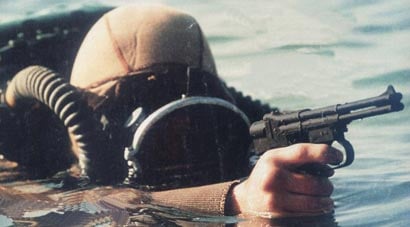

Early British Navy frogman.
So you are a frogman and, while you are froggin it up, you come snorkel-to-snorkel with another wetsuit-clad combat swimmer. You reach for your dive knife but come up short because you realize that you just brought a knife to a gunfight. Well, that dastardly commie has a SPP-1 pistol, and it works underwater.
Why the need
Underwater divers have been used by militaries around the world for centuries. As far back as the 1843, the British Royal Navy and others used divers for salvage. However, these early divers were tethered to the surface by lines that fed oxygen. The first ‘frogmen’ who swam independent of support ships had to do so with just a set of fins, a facemask, and a knife. These early combat swimmers reconned beaches in World War 2 as well as planted explosives when the opportunity arose.
It wasn’t until self-contained breathing apparatus including open and closed circuit varieties came about in the late 1940s that military divers could stay below the surface for longer periods. This new technology led to a greater flexibility of operations that included the laying of limpet mines on enemy ships in harbor. Soon most modern navies had specialized teams of frogmen optimized for underwater recon, sabotage, and other dirty deeds done dirt-cheap.
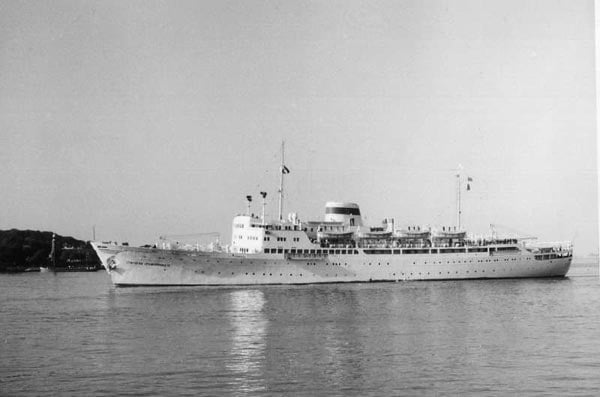
The Soviet crusier, Ordzhonikidze.
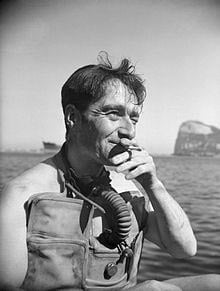
Lionel Kenneth “Buster” Crabb.
In 1956, the Soviets and British both caught a dose of diver versus diver combat. The cruiser Ordzhonikidze was visiting the British base of Portsmouth and Lionel Kenneth “Buster” Crabb, a former Royal Navy diver thought to be in the employ of British Intelligence, disappeared in the harbor during the ships visit. Fourteen months later, his body, sans head and hands, washed up. In 2007, a former Russian frogman finally claimed to the press that he had killed Crabb with a knife as the Brit poked around the Ordzhonikidze some fifty years before. It was the only weapon available.
It was this incident and others that may never be known that led the Soviets to develop an underwater pistol.
Design

SPP1 underwater pistol open for loading.
The man selected to turn out such a weapon was Vladimir Simonov (no relation to SKS inventor Sergei Simonov) of the TsNIITochMash plant. His design was a simple four-barreled hinged-break pistol that shot a very special round. More or less a giant derringer, the gun had one round in each chamber with an opening in the bolt face of each for the striker. The double-action trigger cycled the rotating striker, firing each 8-inch long smoothbore barrel in turn with each trigger pull. Since it was designed to be carried and used in the harshest saltwater of the world’s oceans, the gun was to be built of non-corrosive metals with specially coated internals and plastic furniture. To accommodate the thick neoprene gloves of divers operating in subzero waters, the trigger guard and combination safety lever/barrel hinge lock are oversized.
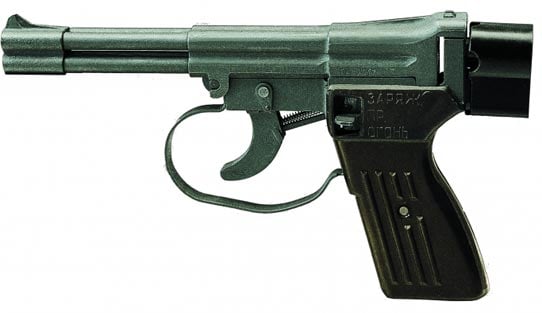
SPP-1 underwater pistol.

SSP-1 underwater pistol.
The resulting gun was quite long, at 9.65-inches overall (more than an inch longer than the Colt 1911, which you can see shoot underwater here) with an empty weight of 30-ounces. One reason for its magnum-size envelope is to allow greater tolerances for the gun to be fired while completely immersed at depths up to 150-feet.
Classified as the Spetsialnyj Podvodnyj Pistolet (Russian for ‘Special Underwater Pistol,’ apparently to differentiate it from the plain underwater pistol) model 1, its moniker is commonly shortened to SPP-1 when written.

SPP-1 with ammunition and other accessories.
The ammunition intended for this frog-gun was the specially designed SPS round, consisting of a 4.5mm caliber mild-steel flechette dart loaded atop a 39.5mm bottlenecked case. The overall look is as if you took a .223 case and stuck a four-inch steel dart into the opening, only stranger. When fired underwater it is drag-stabilized and accurate to about 50-feet. A blunt tip and finned tail allowed it to create a wave of cavitation in front of it as it moved through the water, retaining velocity over distance. This hopped up spear/bullet is capable of penetrating hard glass facemasks and thick neoprene wetsuits.

4.5×39.5 R. Note the blunt tip to help the projectile cavitate.
While both the gun and the ammunition can still be fired on land, range out of water is poor as is accuracy. For quick loading/reloading, a spring steel clip that can be replaced as a unit holds all four rounds together. This is helpful in dark, underwater environments by divers with gloved hands.
Use and competition
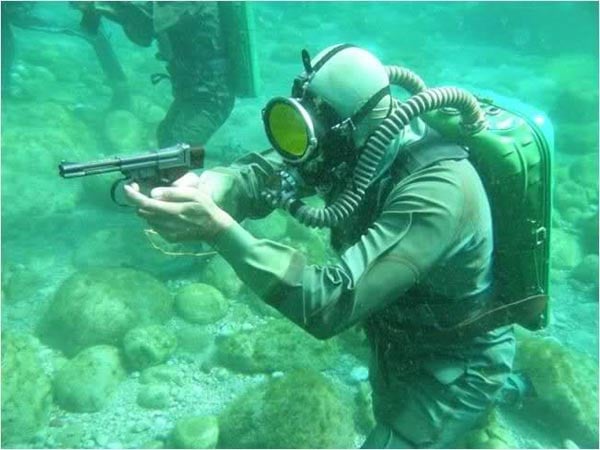
Soviet SPP-1 underwater pistol in use by Russian frogman.
Designed throughout the 1960s the SPP-1 was placed into low-rate production at the Tula works in 1971. The Soviets during this period had thousands of naval spetsanz troops, roughly their version of our Navy Seals, that were undoubtedly issued these guns. While their operations during the Cold War are written in invisible ink in books that you aren’t cleared to read, you can no doubt safely wager they were used occasionally. The success of the design led to Simonov’s creation of a larger, APS underwater assault rifle system.

Chinese knock-off SPP-1 pistol.
When word hit the street about the Russki’s underwater arsenal, the NATO guys went about getting their own cooler version. Made in the 1970s, the German-made HK P11 met the Soviet 4-shot 4.5×39.5R with a 5-shot 7.62x36mm underwater dart gun. Incapable of being reloaded, the device was in effect disposable. The German gun was bulkier but slightly smaller and fired from an electrical ignition—but that’s another article.
While it’s believed the HK scuba sniper has long been discontinued, the SPP-1 is still going strong and is still in current production by TsNIITochMash (where it was invented.) The Chinese liked the design so much that they created the “Type QSS05 underwater pistol,” a near copy, from the Soviet original. Today, as the slightly improved SPP-1M, it’s used by the Russian Navy as well as sold for export to any country close to Moscow with a bank account.
SPP-1 Underwater Pistol
caption=
origin=flagcountry|Soviet Union
type=Underwater Pistol
is_ranged=yes
service=
used_by=
wars=
designer=
design_date=
manufacturer= TSNIITOCHMASH
production_date=1971
number=
variants=
weight=950 g empty
length=244 mm (9.606 inches)
part_length=
width=37 mm
height=136 mm
crew=
cartridge=
caliber= 4.5x40R
action=
rate=
velocity= 240-250 m/s in air
range= in air, 20 m; in water, 17 m at depth of 5 m; 11 m at depth of 20 m; 6 m at depth of 40 m
max_range=
feed= 4 barrels with a cartridge in each
sights= The 4.5 mm SPP-1 Underwater Pistol was made in the USSR for use underwater by Soviet frogmen as an underwater firearm . It was developed in the late 1960s and accepted for use in 1971. Underwater, ordinary-shaped bullets are inaccurate and very short-range. As a result, this pistol fires a round-based 4.5mm caliber steel dart about 4.53 inches (115 mm) long, weighing 12.8 g, which has longer range and more penetrating power than speargun spears. The complete cartridge is 145 mm = 5.71 inches long and weighs 17.5 g. It has four barrels, each containing one cartridge. Its ammunition comes as a magazine of four cartridges which is inserted into the pistol’s breech.
Its barrel is not rifled; the fired projectile is kept in line by hydrodynamic effects. As a result, it is somewhat inaccurate when fired out of water.
Depth reduces range because the higher pressure closes the cavity sooner. Once the projectile is no longer supercavitating, hydrodynamic drag increases greatly, and the projectile becomes unstable.
Its stated lethal range is the range from which it can easily penetrate a padded underwater suit or a 5 mm thick glass facepiece.
A double-action firing mechanism fires one cartridge sequentially for each pull of the trigger. When all four cartridges are spent, the gun can be reloaded above or below water.
A complete set of SPP-1 equipment includes the pistol, 10 cartridge magazines, holster, an ammunition clip for loading SPS cartridges into the magazines and a special sling to carry the pistol and three containers with loaded magazines.
The SPP-1M pistol is essentially the same as the SPP-1 but:-
* It has an extra spring above the sear to improve the trigger pull.
* Its trigger guard is larger to accommodate diving gloves.
ee also
* Underwater firearm
* List of Russian Weaponry
External links
* [http://world.guns.ru/handguns/hg140-e.htm Picture and information]
* [http://www.securityarms.com/20010315/galleryfiles/2100/2153.htm Technical specification]
* [http://www.cruffler.com/trivia-November01.html Description, image of firearm and darts, and specifications]
* [http://www.kgb-militaryschool.com/view/spp-1m Image of firearm, breech opened, and specifications]
Wikimedia Foundation . 2010 .
Look at other dictionaries:
SPP — or spp as an abbreviation or initialism can refer to several things:* Samoan Plantation Pidgin, an English based pidgin language that was spoken by plantation workers in Samoa * Science Power Platform, planned Russian module of the International… … Wikipedia
Underwater firearm — An underwater firearm is a firearm specially designed for use underwater by frogmen. Underwater firearms were first conceived during the Cold War during the 1960s and 1970s as a way to arm frogmen, and remain in arms inventories today. A common… … Wikipedia
APS Underwater Assault Rifle — Infobox Weapon name=APS caption= origin=flagcountry|Soviet Union type=Underwater Assault rifle is ranged=yes service= used by= wars= designer= Mikhail Kalashnikov design date= manufacturer= production date= number= variants= weight=2.4 kg (5.29… … Wikipedia
Mk 1 Underwater Defense Gun — M1 Underwater Defense Gun Type Underwater Pistol Place of origin United States … Wikipedia
ASM-DT Underwater Assault Rifle — Infobox Weapon name= ASM DT Underwater Assault Rifle caption= origin= flagcountry|Soviet Union type= Underwater Assault rifle is ranged=yes is bladed= is explosive= is artillery= is vehicle= is missile= is UK= service= 2000s used by= wars=… … Wikipedia
List of multiple barrel firearms — This page is a list of multiple barrel firearms of all forms from around the world.[1] Contents 1 Pistols 2 Revolvers 3 Shotguns 4 … Wikipedia
APS amphibious rifle — APS APS underwater rifle with 5.66 mm cartridge Type Underwater Assault rifle … Wikipedia
List of firearms — This is an extensive list of small arms pistol, machine gun, grenade launcher, anti tank rifle that includes variants. 0 9*977 Bowing rifle ( Russian Rifle) *90 1000 Assault Rifle ( American Rifle) *9A 91 (Russia Carbine Assault Rifle 9 x 39… … Wikipedia
Frogman — This article is about a type of military diver. For other uses, see Frogman (disambiguation). A French frogman with bag on chest rebreather with 2 breathing tubes (model Oxygers , 1957) … Wikipedia
Liste der Handfeuerwaffen/S — Liste der Handfeuerwaffen A B C D E F G H I J K L M N … Deutsch Wikipedia
Simonov SPP-1
Underwater Pistol


During the late 1960s Soviet engineers worked on providing a new kind of weapon for specialist troops operating underwater. This became the Simonov SPP-1 “underwater pistol” introduced in 1971. Design of the SPP-1 fell to Vladimir Simonov who also lent his talents to the upcoming APS “underwater assault rifle” of 1975 (detailed elsewhere on this site). The cartridge was a joint design approach headed by Oleg Kravchenko and Pyotr Sazonov. Manufacture of the pistol has been through TOZ / Tula Arms Plant and the pistol may still be in service with Russian special forces today (2015).
The SPP-1 fires a specially-made 4.5x40mmR 5.7″-long cartridge (essentially a small, slim dart fitted as the nose of a standard Soviet 7.62x39mm case) from a unique four-barreled arrangement (stacked as 2×2 square). Reloading involves a break-action system which exposes the barrels near the breech of the gun. Four darts are clipped as a single unit for ease in reloading. The trigger is of a Double-Action (DA) design and a smoothbore barrel guides the projectile at least to the muzzle of the firearm. From there, hydrodynamics are relied upon to keep the outgoing projectile on its path towards the target – effective range underwater being about 55 feet in 16 feet of water. As pressures change in deeper water, range and effectiveness is reduced. This design element limits the value of the SPP-1 when firing out of the water as the smoothbore barrel does not aid in ranged accuracy as much – effective range being about 50-60 feet with accuracy variable. Muzzle velocity is rated at 790 to 820 feet per second. Nevertheless, this is a weapon for specialist troops to be fired under special conditions and in that role it succeeds.
The weapon is not necessarily compact featuring a length of 9.6 inches, a width of 1.5 inches and a height of 5.4 inches. Weight is about 36 ounces when loaded. The large trigger ring makes the weapon particularly cumbersome.
The “SPP-1M” model was brought along with some refinements to the base SPP-1 design, namely in introducing an additional spring for improved trigger pull and an enlarged trigger ring so the weapon could be more easily used by a gloved hand.
Despite its 1960s origins, the SPP-1 was not publically revealed until the 1990s.



